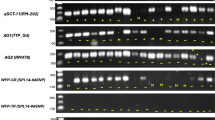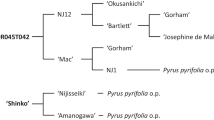Summary
Due to the complex requirements of moisture stress, substantial genetic diversity with a wide array of character combinations and effective simultaneous selection for several variables is necessary for improving the productivity and adaptation of a component crop in order for it to fit into a cropping system under semi-arid tropical conditions. Sesamum indicum L. is grown in Venezuela after rice/sorghum/or maize under such conditions. A mutation breeding program was undertaken using six locally adapted varieties to develop genotypes suitable for the above system. The diversity pattern for nine variables was assessed by multivariate analysis in 301 M4 progenies. Analysis of the characteristic roots and principal components in three methods of selection, i.e., M2 bulks (A), individual plant selection throughout (B), and selection in M3 for single variable (C), revealed differences in the pattern of variation between varieties, selection methods, and varieties x methods interactions. Method B was superior to the others and gave 17 of the 21 best M5 progenies. ‘Piritu’ and ‘CF’ varieties yielded the most productive progenies in M5 and M6. Diversity was large and selection was effective for such developmental traits as earliness and synchrony, combined with multiple disease resistance, which could be related to their importance by multivariate analyses. Considerable differences in the variety of character combinations among the high yielding. M5 progenies of ‘CF’ and ‘Piritu’ suggested possible further yield improvement. The superior response of ‘Piritu’ and ‘CF’ over other varieties in yield and adaptation was due to major changes in plant type and character associations. Multilocation testing of M5 generations revealed that the mutant progenies had a 40%–100% yield superiority over the parents; this was combined with earliness, synchrony, and multiple disease resistance, and was confirmed in the M6 generation grown on a commercial scale. This study showed that multivariate analysis is an effective tool for assessing diversity patterns, choice of appropriate variety, and selection methodology in order to make rapid progress in meeting the complex requirements of semi-arid cropping systems.
Similar content being viewed by others
References
Arunachalam V, Owen ARG (1971) Polymorphism with linked loci, 1st edn. Chapman and Hall, London
Ashri A (1982) Status of breeding and prospects for mutation breeding in peanuts, sesame and castor beans. In: Improvement of oil-seed and industrial crops by induced mutations. IAEA, Vienna, 1982, STI/PUB/608:65–80
Beaver JS, Copper RL (1982) Dry matter accumulation and seed yield components of two indeterminate soybean cultivars. Agron J 74:380–383
Bedigian D, Harlan JR (1983) Nuba agriculture and ethnobotany with particular reference to sesame and sorghum. Econ Bot 37:384–395
Brand PJ, Hing PN, Green DE, Shibles RM (1984) Use of principal factors analysis in the study of three stem termination types of soybeam. Euphytica 33:387–400
Brock RD (1971) The role of induced mutations in plant improvement. Radiat Bot 11:181–196
Foley TC, Orf JH, Lambert JW (1986) Performance of related determinate and indeterminate soybean lines. Crop Sci 26:5–8
Lee JJ, Lee ST, Kang CW, Oh SG, Seong NS, Han YS (1985) A new resistant and high yielding sesame variety Ansanggae. Rep Rural Develop Administration 27:199–202
Lee JJ, Kang CW, Son ER (1986) Studies on flowering and maturity in sesame (Sesamum indicum L.). VI. Grain filling rate for differently positioned capsules in different plant types. Korean J Crop Sci 31:214–219
Mazzani B (1985) Sesame growing in Venezuela 1980–1984. FAO Plant Prod Prot Paper 66:86–89
Micke A (1985) List of varieties developed by mutation breeding. Mutat Breed News 27:25–27
Murty BR (1971) Developmental traits in disease resistance in some cereals. IAEA Publ No STI Pub 271:93–105
Murty BR (1979) Selection of parental material, breeding methods and evaluation procedures in developing improved crop varieties. Indian J Genet Plant Bred 39: 305–314
Murty GSS, Joshua DC, Rao NS, Bhatia CR (1985). Induced mutation in sesame. In: Sesame and safflower: status and potentials. FAO Plant Prod Prot Paper 66 (ISBN 92-5-102306-9): pp 188–190
Oropeza F, Murty BR, Bravo R (1984) Mutation breeding in Ajonjoli (Sesamum indicum L.) for adaptation to the cropping system in Venezuela. In: Induced mutations for crop improvement in Latin America. IAEA (Vienna) TECDOC 305:285–298
Sasikala S, Kamala T (1985) Ethidium bromide (EB) induced mutants in gingelly (Sesamum indicum L.) cultivar “Vinayak”. Theor Appl Genet 70:307–308
Swank JC, Egli DB, Pfeiffer TW (1987) Seed growth characteristics of soybean genotypes differing in duration of seed fill. Crop Sci 27:85–89
Taborda F, Murty BR (1985) Some aspects of tropical adaptation in sorghum. Genet Agrar 29:121–130
Torres ICI (1985) Productiòn del Ajonjolì en Mèxico. Sesame and safflower: status and potentials. FAO Plant Prod Prot paper 66 (ISBN 92-5-102306-9):80–82
Author information
Authors and Affiliations
Additional information
Communicated by G. Wenzel
Project supported by the International Atomic Energy Agency, Vienna, Austria
Rights and permissions
About this article
Cite this article
Murty, B.R., Oropeza, F. Diversity pattern in Sesamum mutants selected for a semi-arid cropping system. Theoret. Appl. Genetics 77, 275–286 (1989). https://doi.org/10.1007/BF00266198
Received:
Accepted:
Issue Date:
DOI: https://doi.org/10.1007/BF00266198




